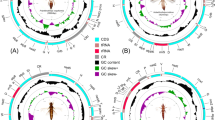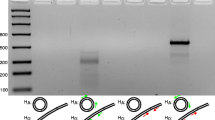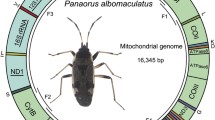Abstract
Mitochondrial (mt) genome rearrangement has generally been studied with respect to the phenomenon itself, focusing on their phylogenetic distribution and causal mechanisms. Rearrangements have additional significance through effects on substitution, transcription, and mRNA processing. Lice are an ideal group in which to study the interactions between rearrangements and these factors due to the heightened rearrangement rate within this group. The entire mt genome of the screamer louse Bothriometopus was sequenced and compared to previously sequenced louse genomes. The mt genome is 15,564 bp, circular, and all genes are encoded on the same strand. The gene arrangement differs radically from both other louse species and the ancestral insect. Nucleotide composition is A+T biased, but there is no skew which may be due to reversal of replication direction or a transcriptional effect. Bothriometopus has both tRNA duplication and concerted evolution which has not been observed previously. Eleven of the 13 protein-coding genes have 3′ end stem-loop structures which may allow mRNA processing without flanking tRNAs and so facilitate gene rearrangements. There are five candidate control regions capable of forming stem-loop structures. Two are structurally more similar to the control regions of other insect species than those of other lice. Analyses of Bothriometopus demonstrate that louse mt genomes, in addition to being extensively rearranged, differ significantly from most insect species in nucleotide composition biases, tRNA evolution, protein-coding gene structures and putative signaling sites such as the control region. These may be either a cause or a consequence of gene rearrangements.




Similar content being viewed by others
References
Altschul SF, Madden TL, Schäffer AA, Zhang J, Zhang Z, Miller W, Lipman DJ (1997) Gapped BLAST and PSI-BLAST: a new generation of protein database search programs. Nucleic Acids Res 25:3389–3402
Baumann L, Baumann P (2005) Cospeciation between the primary endosymbionts of mealybugs and their hosts. Curr Microbiol 50:84–87
Berthier F, Renaud M, Alziari S, Durand R (1986) RNA mapping on Drosophila mitochondrial DNA: Precursors and template strands. Nucleic Acids Res 14:4519–5433
Boore JL (1999) Animal mitochondrial genomes. Nucleic Acids Res 27:1767–1780
Boore JL, Brown WM (2000) Mitochondrial genomes of Galathealinum, Helobdella, and Platynereis: Sequence and gene arrangement comparisons indicate that Pogonophora is not a phylum and Annelida and Arthropoda are not sister taxa. Mol Biol Evol 17:87–106
Brehm A, Harris DJ, Hernández M, Cabrera VM, Larruga JM, Pinto FM, González AM (2001) Structure and evolution of the mitochondrial DNA complete control region in the Drosophila subobscura subgroup. Insect Mol Biol 10:573–578
Bogenhagen DF, Clayton DA (2003) The mitochondrial DNA replication bubble has not burst. Trends Biochem Sci 28:357–360
Brugler MR, France SC (2007) The complete mitochondrial genome of the black coral Chrysopathes Formosa (Cnidaria: Anthozoa: Antipatharia) supports classification of antipatharians within the subclass Hexacorallia. Mol Phylogen Evol 42:776–788
Castro LR, Austin AD, Dowton M (2002) Contrasting rates of mitochondrial molecular evolution in parasitic Diptera and Hymenoptera. Mol Biol Evol 19:1110–1113
Castro LR, Ruberu K, Dowton M (2006) Mitochondrial genomes of Vanhornia eucnemidarum (Apocrita: Vanhorniidae) and Primeuchroeus spp. (Aculeata: Chrysididae): Evidence of rearranged mitochondrial genomes within the Apocrita (Insecta: Hymenoptera). Genome 49:752–766
Clayton DA (1982) Replication of animal mitochondrial DNA. Cell 28:693–705
Cameron SL, Beckenbach AT, Dowton M, Whiting MF (2006) Evidence from mitochondrial genomics on interordinal relationships in insects. Arthrop System Phylogen 64:27–34
Cameron SL, Whiting MF (2007) Mitochondrial genome comparisons of the subterranean termites from the genus Reticulitermes (Insecta: Isoptera: Rhinotermitidae). Genome 50:188–202
Covacin C, Shao R, Cameron S, Barker SC (2006) Extraordinary number of gene rearrangements in the mitochondrial genomes of lice (Phthiraptera: Insecta). Insect Mol Biol 15:63–68
Dowton M, Austin AD (1999) Evolutionary dynamics of a mitochondrial rearrangement “hot spot” in the Hymenoptera. Mol Biol Evol 16:298–309
Dowton M, Campbell NJ (2001) Intramitochondrial recombination – is it why some mitochondrial genes sleep around. Trends Ecol Evol 16:269–271
Dowton M, Castro LR, Austin AD (2002) Mitochondrial gene rearrangements as phylogenetic characters in the invertebrates: The examination of genome “morphology”. Invert Syst 16:345–356
Dowton M, Castro LR, Campbell SL, Bargon SD, Austin AD (2003) Frequent mitochondrial gene rearrangements at the hymenoptera nd3-nd5 junction. J Mol Evol 56:517–526
Drummond AJ, Kearse M, Heled J, Moir R, Thierer T, Ashton B, Wilson A, Stones-Havas S (2006) Geneious ver2.5; available at http://www.geneious.com/
Dubrovsky EB, Dubrovskaya VA, Levinger L, Schiffer S, Marchfelder A (2004) Drosophila RNase Z processes mitochondrial and nuclear pre-tRNA 3′ ends in vivo. Nucleic Acids Res 32:255–262
Faith JJ, Pollock DD (2003) Likelihood analysis of asymmetrical mutation bias gradients in vertebrate mitochondrial genomics. Genetics 165:735–745
Fenn JD, Cameron SL, Whiting MF (2007) The complete mitochondrial genome sequence of the Mormon cricket (Anabrus simplex: Tettigoniidae: Orthoptera) and an analysis of control region variability. Insect Mol Biol 16:239–252
Fonseca MM, Froufe E, Harris DJ (2006) Mitochondrial gene rearrangements and partial genome duplications detected by multigene asymmetric compositional bias analysis. J Mol Evol 63:654–661
Foster PG, Jermiin LS, Hickey DA (1997) Nucleotide composition bias effects amino acid content in proteins coded by animal mitochondria. J Mol Evol 44:282–288
Francino MP, Ochman H (1997) Strand asymmetries in DNA evolution. Trends Genetics 13:240–245
Frank DN, Pace NR (1998) Ribonuclease P: Unity and diversity of a tRNA processing ribozyme. Ann Rev Biochem 67:153–180
Goddard JM, Wolstenholme DR (1980) Origin and direction of replication in mitochondrial DNA molecules from genus Drosophila. Nucleic Acids Res 8:741–757
Hafner MS, Sudman PD, Villablance FX, Spradling TA, Demaster JW, Nadler SA (1994) Disparate rates of molecular evolution in cospeciating hosts and parasites. Science 365:1087–1090
Hassanin A, Léger N, Deutsch J (2005) Evidence for multiple reversals of asymmetric mutational constraints during the evolution of the mitochondrial genome of Metazoa, and consequences for phylogenetic inferences. Syst Biol 54:277–298
He Y, Jones J, Armstrong M, Lamberti F, Moens M (2005) The mitochondrial genome of Xiphinema americana sensu stricto (Nematoda: Enoplea): Considerable economization in the length and structural features of encoded genes. J Mol Evol 61:819–833
Helfenbein K, Brown WM, Boore JL (2001) The complete mitochondrial genome of the articulate brachiopod Terebratalia transversa. Mol Biol Evol 18:1734–1744
Higgs PG, Jameson D, Jow H, Rattay M (2003) The evolution of tRNA-Leu genes in animal mitochondrial genomes. J Mol Evol 57:435–445
Hoffmann RJ, Boore JL, Brown WM (1992) A novel mitochondrial genome organization for the blue mussel, Mytilus edulis. Genetics 131:397–412
Johnson KP, Yoshizawa K, Smith VS (2004) Multiple origins of parasitism in lice. Proc Roy Soc London B 271:1771–1776
Kim I, Lee EM, Seol KY, Yun EY, Lee YB, Hwang JS, Jin BR (2006) The mitochondrial genome of the Korean hairstreak, Coreana raphaelis, (Lepidoptera: Lycaenidae). Insect Mol Biol 15:217–225
Kimura M (1983) The Neutral Theory of Molecular Evolution. Cambridge University Press, Cambridge
Kumar S, Tamura K, Nei M (2004) MEGA3: Integrated software for molecular evolutionary genetics analysis and sequence alignment. Brief Bioinform 5:150–163
Lavrov DV, Brown WM (2001) Trichinella spiralis mtDNA: A nematode mitochondrial genome that encodes a putative ATP8 and normally structured tRNAs and has a gene rearrangement relatable to those of coelomate metazoans. Genetics 157:621–637
Lavrov DV, Lang BF (2005a) Poriferan mtDNA and animal phylogeny based on mitochondrial gene arrangements. Syst Biol 54:651–659
Lavrov DV, Lang BF (2005b) Transfer RNA gene recruitment in mitochondrial DNA. Trends Genetics 21:130–133
Lessinger AC, Junqueira ACM, Conte FF, Azeredo-Espin AML (2004) Analysis of a conserved duplicated tRNA gene in the mitochondrial genome of blowflies. Gene 339:1–6
Levinger L, Vasisht V, Greene V, Bourne R, Birk A, Kolla S (1995) Sequence and structure requirements for Drosophila tRNA 5′- and 3′- end processing. J Biol Chem 270:18903–18909
Lewis DL, Farr CL, Farquhar AM, Kaguni LS (1994) Sequence, organisation and evolution of the A+T region of Drosophila melanogaster mitochondrial DNA. Mol Biol Evol 11:523–538
Levinger L, Bourne R, Kolla S, Cylin E, Russell K, Wang X, Mohan A (1998) Matrices of paired substitutions show the effects of tRNA D/T loop sequence on Drosophila RNase P and 3′-tRNase processing. J Biol Chem 273:1015–1025
Littlewood DTJ, Lockyer AE, Webster BL, Johnston DA, Le TH (2006) The complete mitochondrial genomes of Schistoma haematobium and Schistosoma spindale and the evolutionary history of mitochondrial genome changes among parasitic flatworms. Mol Phylogen Evol 39:452–467
Lowe TM, Eddy SR (1997) tRNAscan-SE: a program for improved detection of transfer RNA genes in genomic sequence. Nucleic Acids Res 25:955–964
Macey JR, Larson A, Ananjeva NB, Papenfuss TJ (1997) Replication slippage may cause parallel evolution in the secondary structures of mitochondrial transfer RNAs. Mol Biol Evol 14:30–39
Machida RJ, Miya MU, Nishida M, Nishida S (2002) Complete mitochondrial DNA sequence of Tigriopus japonicus (Crustacea: Copepoda). Mar Biotechnol 4:406–417
Matsushima Y, Garesse R, Kaguni LS (2004) Drosophila mitochondrial transcription factor B2 regulates mitochondrial DNA copy number and transcription in Schneider cells. J Biol Chem 279:26900–26905
Matsushima Y, Adán C, Garesse R, Kaguni LS (2005) Drosophila mitochondrial transcription factor B1 modulates mitochondrial translation but not transcription or DNA copy number in Schneider cells. J Biol Chem 280:16815–16820
Medina M, Collins AG, Takaoka TL, Kuehl JV, Boore JL (2006) Naked corals: Skeleton loss in Scleractinia. Proc Nat Acad Sci USA 103:9096–9100
Mindell DP, Sorenson MD, Dimcheff DE (1998) Multiple independent origins of mitochondrial gene order in birds. Proc Nat Acad Sci USA 95:10693–10697
Moritz C, Brown WM (1987) Tandem duplications in animal mitochondrial DNAs: Variation in incidence and gene content among lizards. Proc Natl Acad Sci USA 84:7183–7187
Mueller RL, Boore JL (2005) Molecular mechanisms of extensive mitochondrial gene rearrangement in plethodontid salamanders. Mol Biol Evol 22:2104–2112
Ogoh K, Ohmiya Y (2007) Concerted evolution of duplicated control regions within an ostracod mitochondrial genome. Mol Biol Evol 24:74–78
Ojala D, Merkel C, Gelfand R, Attardi G (1980) The tRNA genes punctuate the reading of genetic information in human mitochondrial DNA. Cell 22:393–403
Ojala D, Montoyo J, Attardi G (1981) tRNA punctuation model of RNA processing in human mitochondria. Nature 290:470–474
Perna NT, Kocher TD (1995) Patterns of nucleotide composition at fourfold degenerate sites of animal mitochondrial genomes. J Mol Evol 41:353–358
Pittendrigh BR, Clark JM, Johnston JS, Lee SH, Romero-Severson J, Dasch GA (2006) Sequencing of a new target genome: the Pediculus humanus humanus (Phthiraptera: Pediculidae) genome project. J Med Entomol 43:1103–1111
Rawlings TA, Collins TM, Bieler R (2003) Changing identities: tRNA duplication and remolding within animal mitochondrial genomes. Proc Natl Acad Sci USA 100:15700–15705
Reyes A, Gissi C, Pesole G, Saccone C (1998) Asymmetrical direction mutations pressure in the mitochondrial genome of mammals. Mol Biol Evol 15:957–966
Roberti M, Polosa PL, Bruni F, Musicco C, Gadaleta MN, Cantatore P (2003) DmTTF, a novel mitochondrial transcription termination factor that recognises two sequences of Drosophila melanogaster mitochondrial DNA. Nucleic Acids Res 31:1597–1604
Roberti M, Bruni F, Loguercio Polsa P, Gadaleta MN, Cantatore P (2006) The Drosophila termination factor DmTTF regulates in vivo mitochondrial transcription. Nucleic Acids Res 34:2109–2116
Rokas A, Holland PWH (2000) Rare genomic changes as a tool for phylogenetics. Trends Ecol Evol 15:454–459
Ronquist F, Huelsenbeck JP (2003) MRBAYES 3: Bayesian phylogenetic inference under mixed models. Bioinformatics 19:1572–1574
Rubinoff D, Cameron SL, Will K (2006) A genomic perspective on the shortcomings of mitochondrial DNA for “barcoding” identification. J Heredity 97:581–594
Saccone C, De Giogi C, Gissi C, Pesole G, Reyes A (1999) Evolutionary genomics in Metazoa: The mitochondrial DNA as a model system. Gene 238:195–209
Saito S, Tamura K, Aotsuka T (2005) Replication origin of mitochondrial DNA in insects. Genetics 171:1695–1705
Sancar A, Sancar GB (1988) DNA repair enzymes. Ann Rev Biochem 57:29–67
Shao R, Barker SC (2003) The highly rearranged mitochondrial genome of the plague thrips, Thrips imaginis (Insecta: Thysanoptera): Convergence of two novel gene boundaries and an extraordinary arrangement of rRNA genes. Mol Biol Evol 20:362–370
Shao R, Campbell NJH, Barker SC (2001) Numerous gene rearrangements in the mitochondrial genome of the wallaby louse, Heterodoxus macropus (Phthiraptera). Mol Biol Evol 18:858–865
Shao R, Baker SC, Mitani H, Aoki Y, Fukunaga M (2004) Evolution of duplicate control regions in the mitochondrial genomes of Metazoa: A case study with Australasian Ixodes ticks. Mol Biol Evol 22:620–629
Signorovitch AY, Buss LW, Dellaporta SL (2007) Comparative genomics of the large mitochondria in placozoans. Public Lib Sci, Genetics 3:44–50
Steinauer ML, Nickol BB, Broughton R, Orti G (2005) First sequenced mitochondrial genome from the phylum Acanthocephala (Leptorhynchoides thecatus) and its phylogenetic position within Metazoa. J Mol Evol 60:706–715
Swofford DL (2002) PAUP* Phylogenetic Analysis using Parsimony (*and Other Methods). Ver. 4. Sinauer Associates, Sunderland, MA
Taanman J-W (1999) The mitochondrial genome: structure, transcription, translation and replication. Biochim Biophys Acta 1410:103–123
Tanaka M, Ozawa T (1994) Strand asymmetry in human mitochondrial DNA mutations. Genomics 22:327–335
Webster BL, Copley RR, Jenner RA, Mackenzie-Dodds JA, Bourlat SJ, Rota-Stabelli O, Littlewood DTJ, Telford MJ (2006) Mitogenomics and phylogenomics reveal priapulid worms as extant models of the ancestral ecdysozoan. Evol Develop 8:502–510
Yang MY, Bowmaker M, Reyes A, Vergani L, Angeli P, Gringeri E, Jacobs HT, Holt IJ (2002) Biased incorporation of ribonucleotides on the mitochondrial L-strand accounts for apparent strand-asymmetric DNA replication. Cell 111:495–505
Yokobori S-I, Takuya U, Feldmaier-Fuchs G, Paabo S, Ueshima R, Kondow A, Nishikawa K, Watanabe K (1999) Complete DNA sequence of the mitochondrial genome of the ascidian Halocynthia roretzi (Chordata, Urochordata). Genetics 153:1851–1862
Yokobori S-I, Oshima T, Wada H (2005) Complete nucleotide sequence of the mitochondrial genome of Doliolum nationalis with implications for evolution of urochordates. Mol Phylogenet Evol 34:273–283
Zhang DS, Hewitt FM (1997) Insect mitochondrial control region: A review of its structure, evolution and usefulness in evolutionary studies. Biochem Syst Ecol 25:99–210
Zuker M (2003) Mfold web server for nucleic acid folding and hybridization prediction. Nucleic Acids Res 31:3406–3415
Acknowledgments
Kim Baer assisted with the analyses and Terri Weese with revision of earlier drafts. This study was supported by NSF grant DEB0444972.
Author information
Authors and Affiliations
Corresponding author
Electronic supplementary material
Rights and permissions
About this article
Cite this article
Cameron, S.L., Johnson, K.P. & Whiting, M.F. The Mitochondrial Genome of the Screamer Louse Bothriometopus (Phthiraptera: Ischnocera): Effects of Extensive Gene Rearrangements on the Evolution of the Genome. J Mol Evol 65, 589–604 (2007). https://doi.org/10.1007/s00239-007-9042-8
Received:
Revised:
Accepted:
Published:
Issue Date:
DOI: https://doi.org/10.1007/s00239-007-9042-8




